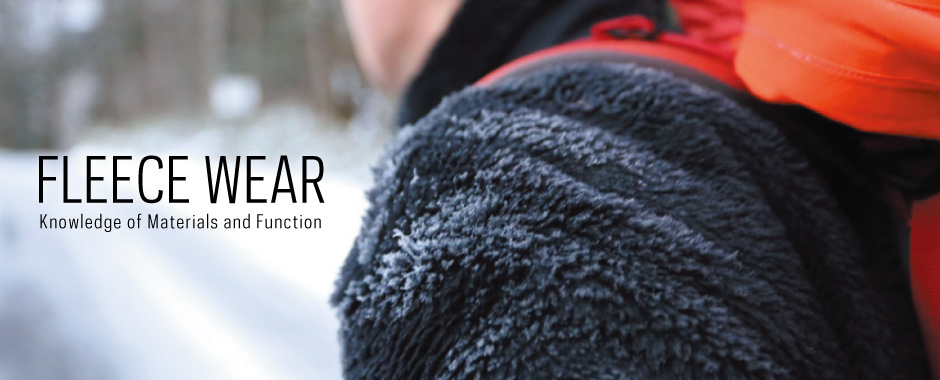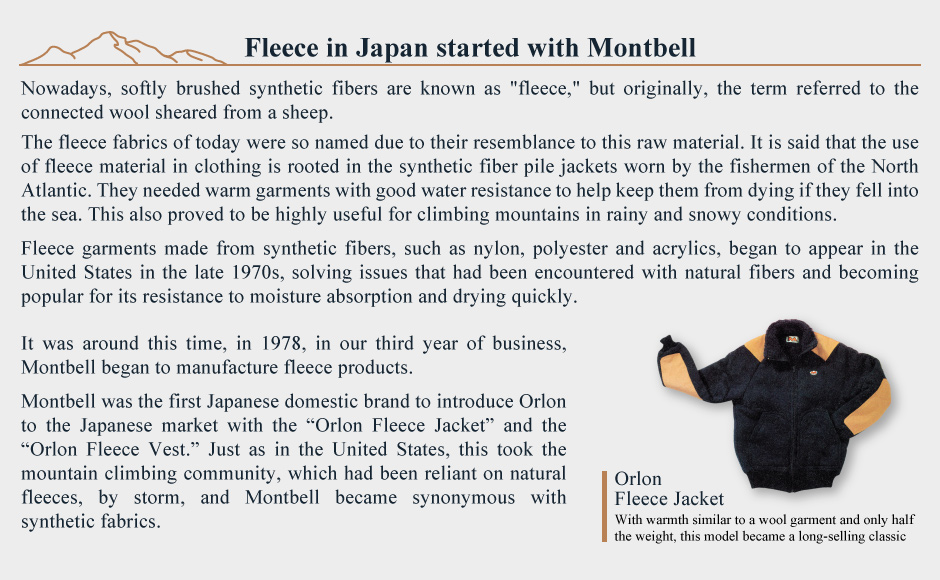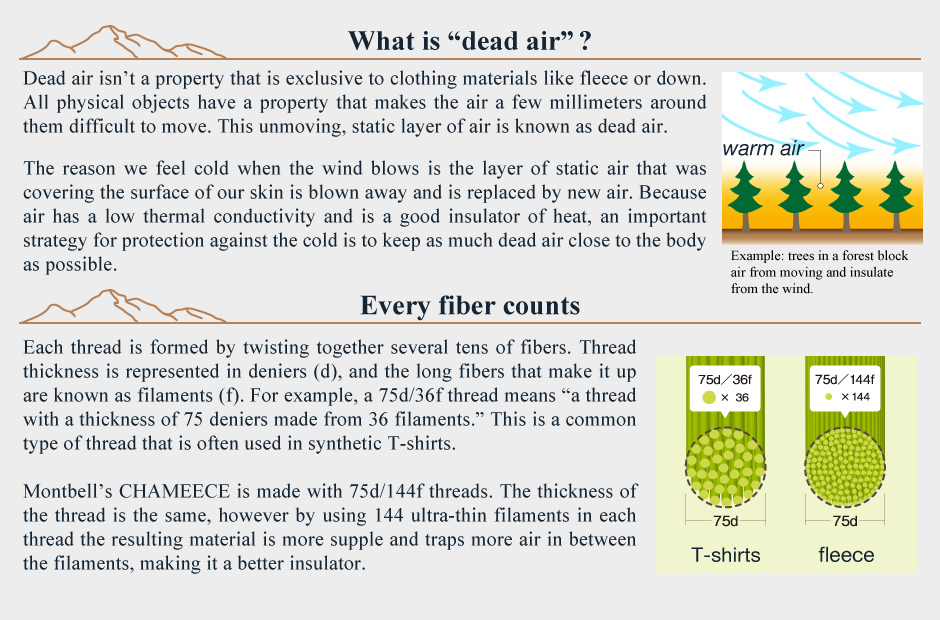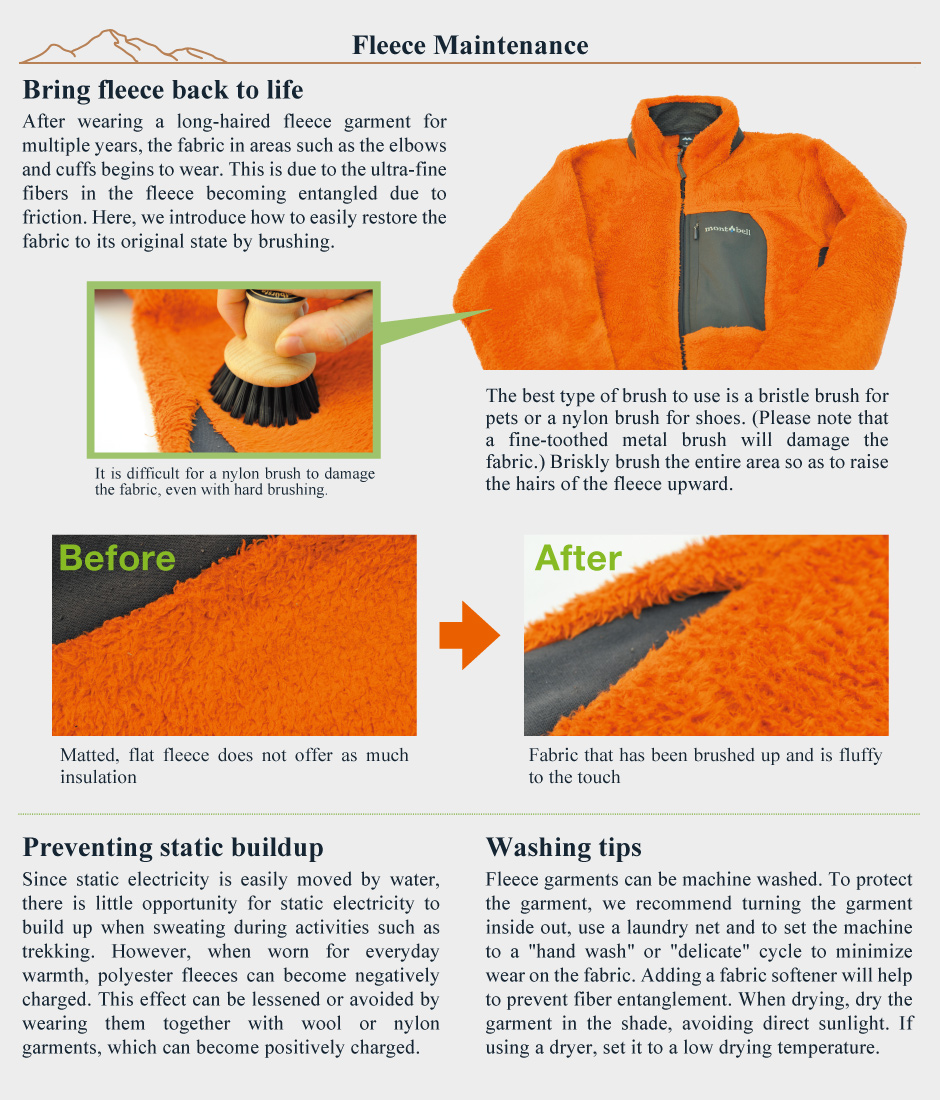History of Montbell's Fleece

In late 1980, Montbell began selling products made with fleece from U.S. company Malden Mills. Malden Mills' Polartec fleece was well known for qualities including visual attractiveness and its ability to maintain its shape. Montbell's Orlon fleece and the subsequently-developed Dacron fleece boasted excellent insulating capabilities, but they both faced an undeniable issue: the buildup of small lint balls, or "pilling," after several years of use.
Around this time, it was Fumiaki Masaki, then Montbell's Director of Development for Fleece Products and now president of the company, who was the first Japanese visitor to Malden Mills' factory. After returning to Japan, he reports that he was earnestly asked a variety of questions by the domestic Japanese fiber manufacturing community, such as what type of equipment the Americans were using for manufacturing. With fleece, even slight variations in the weaving and napping processes can have considerable effects on the quality of the final product. In those days, each company was feverishly working to find the secrets to making the highest-quality material.
In 1997, Montbell worked together with Malden Mills to develop a fleece with further-enhanced properties, including warmth, texture and resistance to pilling. The final product was unveiled as "CLIMAPLUS Fleece." Now, in 2017, Montbell continues to improve its materials and manufacturing methods, using the type of fleece best suited for each of its garments and producing a varied lineup of products, with over 60 different types of jackets and pants alone.

The secret to breathable warmth
The most important properties for a mid-layer garment are insulation and breathability, and fleece has just the right balance in these two areas.
The main ingredients in fleece are polyester and polyethylene terephthalate (or PET) which can be recovered from plastic bottles. Brushing the finished material creates spaces between the fleece's fibers that trap air granting a high level of insulation and creating a seal against outside air. This ability to trap air is also seen in materials like wool and down and because this trapped air doesn’t move, it is sometimes referred to as "dead air."

Compared with down or wool garments, one of the advantages of fleece is the variation available in its hair length, fiber diameter and cloth thickness, which allow us to make suitable fleece garments for any weather condition no matter if it is summer or winter.
Fleece’s breathability helps keep you dry and it also releases just the right amount of built up heat during strenuous activities, such as when breaking trail in waist deep snow. Normally the inside of your clothing would feel “stuff” because the temperature difference inside your clothing is so much higher than your outside environment, but fleece allows this excess heat to pass through the fabric easily.
It is often compared to down for its insulating properties, but thicker varieties of fleece with a windproof lining can prevent heat from escaping between the fibers, allowing it to easily hold its own against such products.

Selecting by fabric thickness
Montbell fleeces are made using a wide variety of different fabrics, offering a rich selection for any season and activity.
Chameece
CHAMEECE fleece is knitted using very thin (less than 1 denier), micropolyester yarns. Like its namesake, the soft leather from the chamois antelope, tightly woven CHAMEECE fleece has a brushed surface for luxurious softness. Weighing only 5.4 ounces per square yard, CHAMEECE is very light. In addition, products made from CHAMEECE are quick drying, wind blocking, warm and durable.
CLIMAPLUS 100
CLIMAPLUS 100 weighs 6.6 ounces per square yard. The fabric is lightweight, thin, and suitable for inner wear and linings.
CLIMAPLUS KNIT
This line of parkas is made with a CLIMAPLUS fleece that weighs 7.5 ounces per square yard. Different from CLIMAPLUS 100 and CLIMAPLUS 200, these parkas are specially knit which gives them a "sweater-like" appearance. These versatile jackets can be worn as an insulating layer during the day when you are charging down the slopes, but they don't look out of place later that evening when you are relaxing at the lodge.
CLIMAPLUS 200
This thick, double-faced fleece weighs 7.8 ounces per square yard and offers two-way stretch. CLIMAPLUS 200 is perfect as a middle layer or sweater.
CLIMAPLUS WOOL
Being a blended fabric, CLIMAPLUS WOOL capitalizes on the inherent strengths of both wool and polyester. This fleece weighs 8.0 ounces per square yard. The result is a soft, comfortable fabric that excels at heat retention, while moving moisture well. Additionally, it's easy to appreciate the anti-bacterial properties and quick drying ability.
CLIMAAIR
Montbell's ClimaAir fleece is exceptionally durable and versatile. ClimaAir is highly breathable and dries quickly. The soft, fur-like fibers trap air to provide incredible warmth at a minimal weight.
ClimaAir fleece compresses easily and can be stuffed into a day pack. Unlike many other fleece fabrics, ClimaAir maintains its insulating ability and resists piling after multiple washings.
CHAMEECE and CLIMAPLUS 100 almost exclusively feature Slantec cuffs. By creating the cuff seams at an angle rather than parallel, this technology allows an easy fit with sleeves that are easy to roll up and don't tighten, a feature perfect for a fleece that is suitable as a mid-layer in a wide variety of situations.
In addition, all of our fleece products that feature zippers are designed so that the zipper will not come into contact with the wearer's chin, which, in addition to preventing the discomfort of a cold zipper touching the skin in cold weather, was also designed as a safety measure to prevent metal components from freezing to skin in extremely cold environments. Montbell fleeces feature articulated patterns for freedom of movement and carefully controlled fiber thickness, providing a garment that offers not only superior insulation but maneuverability and comfort as well.

